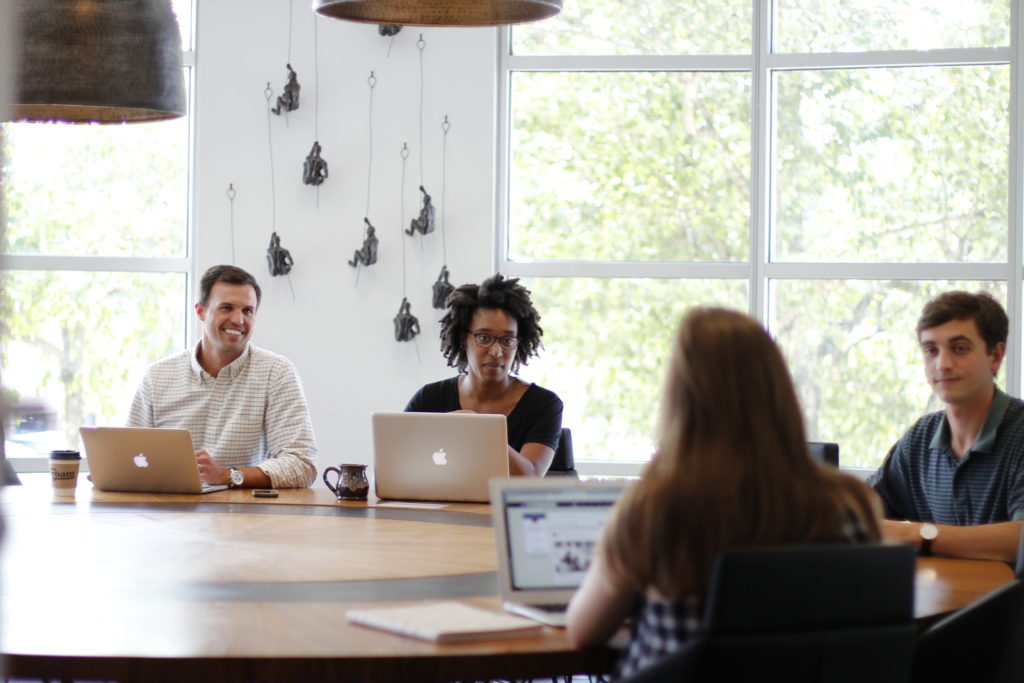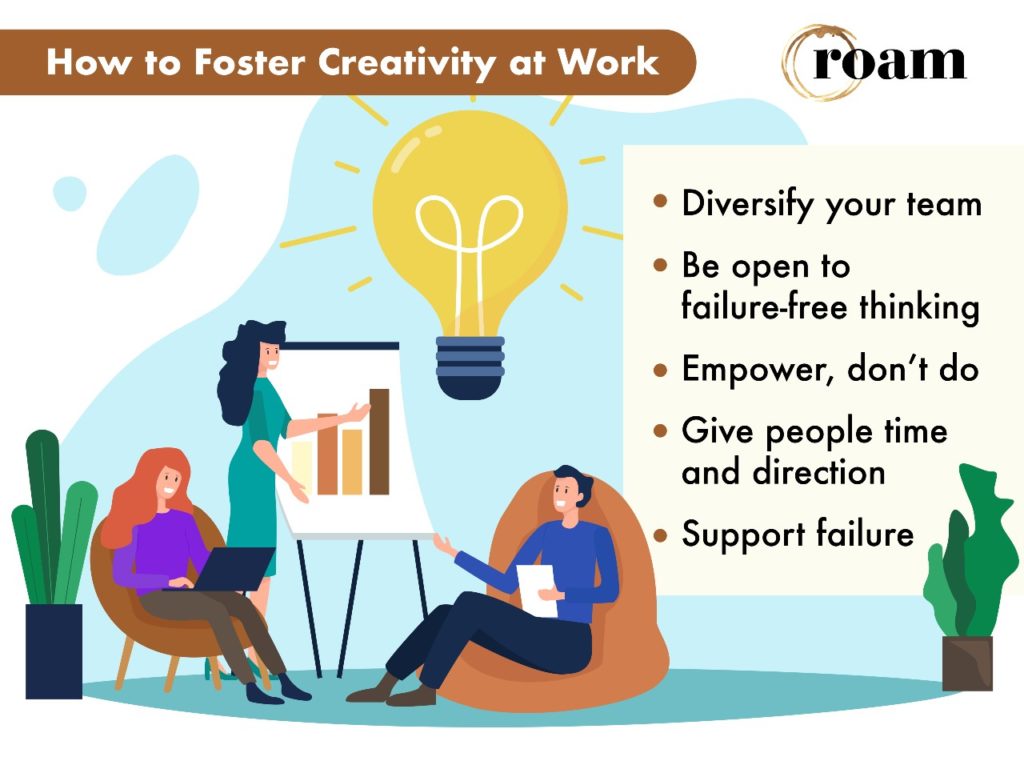Why Creativity is Important in the Workplace
Competition in the business world is fierce. To remain relevant, modern businesses are always seeking innovations that set them apart. When it comes to developing new ideas and opportunities, creativity is the key.
Creativity is important in all industries as it has the power to drive change. It is considered a valuable workplace skill and does not require someone to be a naturally creative person. Creativity is a skill that can be learned and developed over time.
In a workplace setting, business leaders have the chance to approach creativity in a new way. Managers can take the lead and make their workplace a creative environment that fosters problem solving and new perspectives.
What Is Creativity?

Creativity represents the ability to develop unique ideas and turn them into reality. Companies can use the creative process in the workplace to make positive changes that benefit everyday life in and out of the office. Creative thinking encourages human beings to think outside the box and experiment.
Creative expression requires a balance of both artistic and analytical elements. However, you don’t necessarily have to be artistic to be creative. It is an essential skill for everyone to have, not just creative teams. Promoting creative work can help employees become more productive and enhance overall teamwork.
Even if your business is not in the “artsy” field, creativity is worth exploring. Here’s a look at some of the top reasons why creativity is important in the workplace.
1. Creativity Helps You Solve Problems
New problems develop in the workplace every day. While not all problems are at a catastrophic level, they must be overcome to keep the company running smoothly. A creative mindset opens up new possibilities and allows employees to look at issues from a different angle.
It’s common for people to get stuck on solutions that they have used in the past, but resistance to change can stall growth. Creativity helps you see the big picture and come up with original ideas to solve problems. Newfound eagerness to solve problems can also lead to more success and can help organizations run more efficiently.
2. Creativity Builds Confidence
Many employees would not label themselves as a “creative thinker.” However, these individuals are often not given the tools needed to unleash their innovative ideas. Creativity can help build confidence by giving employees something meaningful to do that can be both enjoyable and provide a sense of accomplishment.
Creativity is a form of self-expression that enables workers to share their thoughts and feelings in a way that creates new opportunities. This creative approach helps employees learn new things that they may have otherwise looked over. . For many people, creativity can even be therapeutic.
3. Creativity Inspires New Ways of Thinking
It’s easy to get stuck in a rut, especially when it comes to more complex workplace topics like technology and artificial intelligence. In a digitally focused world, it’s important for businesses to form creative strategies that will help the business grow and thrive.
Great leaders possess the creative energy needed to reframe questions, introduce outside thinking, and force team members to question their assumptions. It encourages employees to bounce ideas off one another and brainstorm solutions to complex problems that may be causing disruptions in the workplace.
4. Creativity Engages the Mind
The mind can be a chaotic place, making it difficult for employees to maintain focus. With so many responsibilities, it can be hard to develop innovative solutions because critical thinking requires extra brainpower. Fortunately, business leaders can teach employees how to cultivate their creative skill.
Reducing distractions in the workplace and practicing mindfulness, can be useful tools designed to turn creative thinking into a habit. Demonstrate the importance of creativity with games and activities that encourage employees to flex their creative muscle, like competing to find the best creative solution to a problem.
5. Creativity Reduces Stress
According to psychologist Dr. Cathy Malchiodi, being creative can help increase positive emotions, reduce depressive symptoms, decrease anxiety, and reduce stress. When absorbed in a creative project, you may experience a loss of all sense and time. This is referred to as ‘flow’, a concept that is known to boost your mood and lessen anxiety.
When you succeed at your creative act, the brain is flooded with dopamine, a ‘feel-good’ chemical that motivates you to continue doing your best. Activities like creative writing and creative problem solving have the potential to make a real difference in the workplace.
6. Creativity Connects People
Creativity has the ability to bring people together. In a workplace setting, this could be departments, teams, or other groups coming together to complete a project or solve a problem. Coming up with a new idea can start a domino effect that encourages other people to develop and share their own ideas.
Business leaders can start the process by providing a creative activity for teams to work on together. Encourage teams to use a range of problem-solving strategies to come up with a creative idea, such as drawing pictures and diagrams or making lists. There is often no correct answer as creativity allows for many possible solutions.
7. Creativity Enhances Productivity
Creativity can enhance productivity in several key ways. First, it can fuel innovation, enabling employees to come up with new ideas that help the business grow. Next, it creates a culture of experimentation, giving workers the confidence needed to change the status quo. Finally, it connects employees to an important and meaningful mission.
Encouraging creativity in the workplace is more important now than ever before. With the rise of remote work, employees can often become distracted, resulting in a loss of productivity. Business leaders can boost creativity among remote workers by providing resources for real-time collaboration, scheduling opportunities for creative thinking, and recognizing creativity when giving feedback.
8. Creativity Can Help You Live Longer
According to a study published in the Journal of Aging and Health, creative people live longer. While the exact reason for this is unclear, researchers believe that creativity draws on a variety of neural networks in the brain. Studies demonstrate that creative activities like creating art reduce negative emotions and improve medical outcomes.
While creativity is not a magic cure for happiness, it can help you achieve a better quality of life. Creative people often find better ways of coping, are naturally more resilient, and are more likely to live in the moment.
9. Creativity Enables Empathy
Both creativity and empathy begin with attention. Employees must pay attention to the information being received in order to reach outside of themselves to find a solution. Empathy is also linked to problem-solving. In a work setting, workers must not only determine what the problem is but who is contributing to the problem.
Creativity is a tool that has challenges, frustrations, and failures. Experiencing these emotions can create a sense of empathy that helps teams embrace failure and encourage feedback.
10. Creativity Encourages Questions
Thought-provoking questions have the ability to prompt positive changes in the workplace. It’s common for employees to go to work, day-after-day, and perform the same tasks without much thought. With that being said, a lack of creativity can hinder business growth.
Creativity is not just an important skill but can help workers develop disparate ideas and promote divergent thinking. Creative thinkers are more likely to ask open-ended and exploratory lead-in questions, such as “Perhaps we could…” or “In what ways can we…”. The ability to pose meaningful questions is a hallmark of creativity.
How to Foster Creativity at Work

- Diversify Your Team – Diversity is essential to creating a creative atmosphere. You don’t need to hand out a creativity test to find the right talent. Look for employees that are unique from one another and have differences in education and experience. Instead of choosing workers that are similar to existing staff members, consider job candidates who can bring something unique to the table.
- Be Open to Failure-Free Thinking – Employees are less likely to express their opinions and embrace their creativity when their ideas are constantly being shot down. While business leaders don’t necessarily need to agree with or affirm an employee’s ideas, it’s best to allow ideas to develop.
- Empower, Don’t Do – Business leaders are often tempted to take over when team members fail. It’s important to allow employees to own up to their mistakes and grow from them. Empower teams to improve and resolve issues on their own.
- Give People Time and Direction – While it’s important not to take over when employees fail or get stuck on a problem, it is crucial to provide some direction. Give teams basic parameters to work with, along with an end goal that aligns with a specified timeline.
- Support Failure – While businesses always want to see their employees succeed, it’s important not to be too harsh when failure happens. Instead, business leaders must learn how to support failure in a way that encourages employees to try again.

Creating and promoting a creative culture within an organization can be a challenging but rewarding endeavor. Through creativity, businesses can thrive by generating higher profits, retaining existing customers, and captivating a new, potential customer base. Roam makes it easy to boost creativity by providing working professionals with a comprehensive work, meet, and office solution. Schedule a tour of Roam in Atlanta or book a room today.
